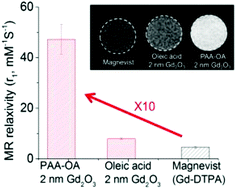Gadolinium oxide nanoplates with high longitudinal relaxivity for magnetic resonance imaging†
Abstract
Molecular-based contrast agents for magnetic resonance imaging (MRI) are often characterized by insufficient relaxivity, thus requiring the systemic injection of high doses to induce sufficient contrast enhancement at the target site. In this work, gadolinium oxide (Gd2O3) nanoplates are produced via a thermal decomposition method. The nanoplates have a core diameter varying from 2 to 22 nm, a thickness of 1 to 2 nm and are coated with either an oleic acid bilayer or an octylamine modified poly(acrylic acid) (PAA–OA) polymer layer. For the smaller nanoplates, longitudinal relaxivities (r1) of 7.96 and 47.2 (mM s)−1 were measured at 1.41 T for the oleic acid bilayer and PAA–OA coating, respectively. These values moderately reduce as the size of the Gd2O3 nanoplates increases, and are always larger for the PAA–OA coating. Cytotoxicity studies on human dermal fibroblast cells documented no significant toxicity, with 100% cell viability preserved up to 250 μM for the PAA–OA coated Gd2O3 nanoplates. Given the 10 times increase in longitudinal relaxivity over the commercially available Gd-based molecular agents and the favorable toxicity profile, the 2 nm PAA–OA coated Gd2O3 nanoplates could represent a new class of highly effective T1 MRI contrast agents.


 Please wait while we load your content...
Please wait while we load your content...